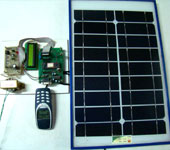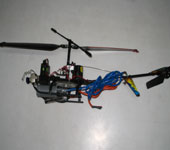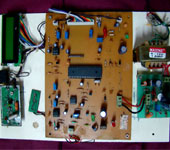Microcontrollers & Use in Embedded Technology
Its fun programming and working with microcontrollers. With microcontrollers you can create a piece of hardware which acts according to your wish (obviously with some limitations !). Examples are you can flash a LED, drive a 7 segment display, print text on a LCD, receive signals from a remote control, control electrical appliances of your room, build a robot that follows a line on the floor and avoids obstacles coming in between, frequency meter and infinitely many more..
Basically a Microcontroller is a mini computer with CPU, Memory, I/O lines etc. Microcontrollers are much better for smaller embedded systems than their ancestors i.e. microprocessors, if you are developing a system using microprocessor, then your hardware or circuit will be more complex whereas if you choose a microcontroller, your hardware becomes simple because all the necessary peripherals such as RAM, ROM, TIMERS, I/O ports etc are embedded in a microcontroller. Therefore it is also called a mini computer on a chip. Now we will start with interfacing various devices to microcontrollers (Assuming you have basic knowledge of 8051 architecture and assembly programming and also C). I have chosen 8051 microcontroller due to its simplicity in architecture and assembly language, and learning 8051 chip is much easier than other microcontrollers if you don’t have any prior knowledge on microcontrollers. For more detailed information of hardware architecture and assembly language of 8051 microcontroller you can refer hardware manual and instruction set from ATMEL’s homepage.
Most of the projects and tutorials published here are based on Atmel’s AT89S52 microcontroller, it is a 8- bit microcontroller with 8051 architecture, comes in a 40 pin DIP, contains all necessary peripherals required for a hobby project. Now for a microcontroller to be operational the minimum hardware you need is a crystal oscillator, power supply, power on reset etc. So I have come up with a very simple development board to carry on the projects and interfacing tutorials published here. (Note: This development board is not compulsory; you can also rig up the circuits in breadboard since most of the circuits are simple). You can construct the development board on a general purpose circuit board. (Soon I will be publishing PCB layout for this).
We will start with interfacing microcontroller with LED’s, Displays, Motors, Relays etc.
· Interfacing 7 segment Display
· Interfacing multiple 7 segment displays
· many more to come…
In order set up your simple home lab, you need
· keil or any other assembler/compiler.
· ISP programmer circuit
· ISP programmer software
· Target hardware (your development board or circuit).
150 Watt amplifier circuit
150 Watt amplifier circuit
Description
This is the cheapest 150 Watt amplifier circuit you can get,I think.Based on two Darlington power transistors TIP 142 and TIP 147 ,this circuit can deliver a blasting 150 W Rms to a 4 Ohm speaker.Enough for you to get rocked?,then try out this.
TIP 147 and 142 are complementary Darlington pair transistors which can handle 5 A current and 100V ,famous for their ruggedness. Here two BC 558 transistorsQ5 and Q6 are wired as pre amplifier and TIP 142 ,TIP 147 together with TIP42 (Q1,Q2,Q3) for driving the transistors.This circuit is designed so rugged that this can be assembled even on a common board or even by pin to pin soldering.The circuit can be powered from a +/-45V 5A dual power supply.You must try this circuit.Its working great.
Circuit Diagram & Parts List .
Notes.
- Remember TIP 142 and 147 are Darlington pairs .They are shown as conventional transistors in figure for ease.So don’t get confused.Even though each of them have 2 transistors ,2 resistors and 1 diode inside ,only three pins ,base emitter and collector are coming out.Rest are connected internally.So its quite OK to assume each of them as transistor for ease.
- Use a well regulated and filtered power supply.
- Connect a 10K POT in series with the input as volume control if you need.Not shown in circuit diagram.
TIP 142 & 147 Internal diagram and pin out.
www.indianengineer.wordpress.com
www.indianengineer.wordpress.com
email Us at
Freshersblog@gmail.com
Remote toggle switch circuit
Remote toggle switch circuit
Remote toggle switch circuit
Description.
In application level this circuit is similar to that of the circuit given previously. The only difference is in the approach. This circuit is designed by using another method. Using this circuit you can toggle any electrical appliance between ON and OFF states by using your TV remote. The only requirement is that your TV remote should be operating in the 38 KHz.
The IC1 (TSOP 1738) is used to receive the infrared signals from the remote. When no IR signal from remote is falling on IC1, its output will be high. When the IR signal from the remote falls on the IC1, its output goes low. This triggers the IC2 which is wired as a monostable multivibrator.The output of the IC2 (pin6) goes high for a time of 1S (set by the values of R2 and C3.This triggers the flip flop (IC2) and its Q output (pin 15) goes high. This switches on the transistor, which activates the relay and the appliance connected via relay is switched ON. For the next press of remote the IC1 will be again triggered which in turn makes the IC2 to toggle its output to low state. The load will be switched OFF. This cycle continues for each press of the remote. The pin 6 and pin 4 of IC1 are shorted to avoid false triggering.The diode D1 can be used as a freewheeling diode.
Circuit diagram with Parts list.
Notes.
- Assemble the circuit on a good quality PCB or common board.
- The circuit can be powered from a 5V DC regulated power supply.
- The capacitors must be rated 15 V.
- The IC1&IC2 must be mounted on holders.
- The current capacity of relay determines the load circuit can switch.Use a high amperage(`10A or above) relay for driving large loads like motor,heater etc.
To Get this Project Contact Us or leave us an Email
At freshersblog@gmail.com.
or Call us at 9717408885
Remote controlled appliance switch circuit
Remote controlled appliance switch circuit
Description.
Here is a versatile remote controlled appliance switch that can ON or OFF any appliance connected to it using a TV remote.
IR remote sensor IC TSOP 1738 is used for recieving the signal. Normally when no signal is falling on IC3 the output of it will be high.This makes Q1 OFF.When a signal of 38 KHz from the TV remote falls on the IC3 its output goes low.This makes Q1 conduct and a negative pulse is obtained at pin 2 of IC 1 NE 555.Due to this IC1 wired as a monostable multivibrator produces a 4 Sec long high signal at its out put.This high out put is the clock for IC 2 which is wired as a Flipflop and of , its two outputs pin 3 goes low and pin 2 goes high.The high output at pin 2 is amplified to drive the relay .For the next signal the outputs of IC2 toggles state. Result, we get a relay toggling on each press on the remote.Any appliance connected to this circuit can be switched ON or OFF.
Circuit Diagram with Parts List .
Notes.
- Before wiring the circuit make sure that the carrier frequency of the TV remote you have is 38 KHz.For that wire the sensor part only ,point your remote to the TSOP1738 and press any switch.If out put of TSOP1738 goes low them ok, your remote is of 38Khz type.Nothing to worry almost all TV remote are of this type.
- You can use any switch because for any switch the code only changes,the carrier frequency remains same.We need this carrier frequency only.
- Assemble the circuit on a good quality PCB or common board.
- The appliance can be connected through NO or NC and contacts of the relay .
www.indianengineer.wordpress.com
email freshersblog@gmail.com
Go to contact us page to contact Us or leave us an email.
We Deals in Projects Kits,circuits,models,presentations,training kits,
Wanna Buy this projects call Us. 9717408885
Low cost projects only at indianEngineer’s
Object Counter
Object Counter
|
Object Counter |
|||||
 Project Object Counter Block Diagram Project Object Counter Block Diagram
The project presented here is based on world’s most powerful microco-ntroller based on intel’s mcs-51 family , generally known as intel-8051. We have used its derivative atmel-89c2051. Operation: A pair of 38khz transmitter and a receive is used to count the objects. Counts pulses are out from the 38khd receiver which are coupled to an opto coupler. At pin 2 out put of the optocoupler is connected to microcontroller pin 8 p3.4. Ic3 an optocoupler will receive incoming count pulse at pin3 and output from pin 5 is connected to p3.4 pinof the ic2 microcontroller, Two line by 16 character on each line (2×16) is used in nibble mode and maximun count can reach upto 65536 there after it will reset to 00000. SW1 is manual reset switch to make the counter to reset to zero. Circuit is driven by 9v 500m.a. transformer connected to PCON1 Diode D1-D4 forms bridge circuit C1,c2 and c3 are filter capacitors and are part of power supply section.. Ic1 7805 is 5v regulator ic to give stablised supply to microcontroller. Ld1 is a power indication led. R1 controls the current flowing thrugh led LD1 Crystal X1 along with C5 and C6 gives the necessary clock to microcontroller. Capacitor C4 and R2 gives the required reset pulse to microcontroller.
Construction: solder all the parts provided in the kit properly. First connect the jumper wires(links) before you solder the ic sockets. Donot solder integrated circuits directly on the circuit board , it may damage the ic since you my not be experianced soldering person. So solder the ic sockets first on the circuit board. Solder smaller components first like resistance and disk capacitors, assemble the complete kit one by one. Please make sure that there are no short circuits left on to the circuit board. Connect the main supply wire with 230v ac pins at one end ,to the 9v transformer towards primary side to the other open end. . Primary side will have high resistance when checked with multimeter. Connect 2pin plug to the secondary side of the transformer(low resistance side) plug the wire to main and check the ac voltage at the plug connected to the secondary of the transformer. It should be 9v ac. Now connect the plug to the socket connected on to the circuit board. Power supply led ld1 will glow. Check the voltage at the output of the regulator. It should be perfactly 5v dc. Check the voltage at the power supply pins of all the sockets mounted on circuit board it should be 5v dc.
|
Please log on to Www.indianEngineer.wordpress.com to Have more Projects or To Get Details of this Project mail us at Freshersblog@gmail.com
Thanks Team IndianEngineers
MICROCONTROLLER BASED PROJECTS(89C51) ieee,EMBEDDED
- WIRELESS MESSAGING VIA MOBILE/LANDLINE
- GSM BASE HOME SECUIRTY SYSTEM
- GSM BASED HOMEAUTOMATION & SECUIRTY
- AUTOMATIC TOLL TAX
- VOTING MACHINE
- SMS BASE DEVICE SWITCH
- SOLAR TARKER SYSTEM
- TEXT DATA COMMUNICATION THROUGH FIBER/LAGER
- DIGITAL COMBINETION LOCK
- SAFETY GUARD FOR THE BLIND (PROXIMITY BASE
- SMS THROUGH TELEPHONE
- SPEED CHECKER FOR HIGHWAYS
- SMART CARD
- DATA SECUIRTY SYSTEM
- TOUCH SCREEN
- HEART BEAT MONITOR
- AUTOMATIC ROOM LIGHT CONTROLLER:
- RADAR SYSTEM ILIGAL AROPLAN DETECTOR
- PRI-PAID CAR PARKING
- MULI LAVEL CAR PARKING
- FASTEST-FINGER-FIRST USING 89C51
- MICRO PROCESSOR BASED REVERSIBLE D.C. MOTOR CONTROL
- STEPPER MOTOR CONTROL USING 89C51
- MIC-89C51 MONITORING SYSTEM
- MANUAL AT 89C51 PROGRAM
- AT 89C2051 BASED COUNTDOWN TIMER
- MICROCONTROLLER BASED CODE LOCK USING AT 89C2051
- LCD FREQUENCY METER USING 89C2051
- CALLER ID UNIT USING MICRO-CONTROLLER
- MICROPROCESSOR-BASED HOME SECURITY SYSTEM
- STEPPER MOTOR CONTROL USING 89C51 MICRO-CONTROLLER
- MICRO CONTROLLER BASED TEMPERATURE METER
- MICRO CONTROLLER BASED HEARTBEAT MONITOR
- ULTRASONICRANGEFINDER USING PIC MICRO CONTROLLER
- CALLER- ID UNIT USING MICRO CONTROLLER
- MICRO CONTROLLER BASED PATHFINDER
- MICRO CONTROLLER BASED ROBOT.
- MICRO CONTROLLER MOVING MESSAGE DISPLAY
- MICRO CONTROLLER BASED RELAY SWITCHING
- MICRO CONTROLLER AUTO DIALER USING GSM.
- MICRO CONTROLLER BASED WATER LEVER INDICATOR
- MICRO CONTROLLER BASED WIRELESS HOME AUTOMATION
- MICROCONTROLLER BASED RADAR SYSTEM
- MULTI CHANNEL INFRA RED CONTROL 4 different point 89c2051 micro controller in transmitter and receiver, using infra red technique.
- MOVING MESSAGE DISPLAY : 89c51 micro controller Led matrix,
- Digital clock with alarm: using 89c51 micro controller
- TRAFFIC LIGHT WITH DOWN COUNTER : all the four sides of the road with one side counter display using 89c51 micro controller circuit.
- ULTRASONIC DISTANCE METER USING MICROCONTROLLER
- PRI-PAID CAR PARKING SYSTEM
- MICRO CONTROLLER TEMPERATUIRE METER
- ANOLOG TO DIGITAL CONERTER USING AT89C51 MCU
- INFARED REMOTE CONTROLE SYSTEM
- ULTRASONIC MOVEMENT DETECTOR
- MICROCONTROLLER BASED TACHOMETER
- MCU BASED VISITOR COUNTER
- PWM CONTROL OF DC MOTOR USING 89C51
- AN INTELLIGENT AMBULANCE CAR WHICH CONTROL TO TRAFFIC LIGHT
- PRE-PAID ENERGY METER
- MICROC CONTROLLER BASED LINE FOLLOWER OR TRACING ROBOT
- AUTOMATED WALKING ROBOT CONTROLLED BY MCU
- AUTO BRAKING SYSTEM
- AUTOMATIC RAILWAY CROSSING GATE CONTROLLER
To Book your project please Click here
Subscribe here for free SMS updates on ur Mobile





















 PROJECTS TO GET COSTLY as demand will increase as exams reach so HURRY to GET it on TIME
PROJECTS TO GET COSTLY as demand will increase as exams reach so HURRY to GET it on TIME





